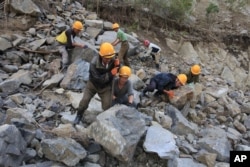Winter is coming in North Korea, where nearly 600,000 people are in need of urgent assistance due to recent severe flooding.
A typhoon that hit at the end of September inundated villages near the Tumen River, along the border areas with China and Russia.
Worst flooding in memory
Relief agencies report that 138 people have died so far, 400 are still missing and 70,000 have been displaced by one of the worst humanitarian disasters to affect North Korea, since the droughts in the 1990s that caused, in part, widespread suffering and starvation.
The floods have destroyed 20,000 homes as well as numerous schools and hospitals, and washed away 30,000 hectares of crops that were nearing harvest.
Paolo Fattori, the North Korea program director for the humanitarian organization Save the Children, says there is need of immediate assistance to provide clean water and food, and to build new shelters for the flood victims in the next few weeks before the temperatures in the region drop below zero.
“In all these areas there is a strong need for support, actually because this event occurred at the end of the summer season, which means that the time to respond is very, very short,” said Fattori.
The United Nations Children's Fund (UNICEF), working with other relief agencies, is calling for $28.2 million for both immediate aid, and long term assistance to help rebuild homes, schools and hospitals that were lost, and to repair damaged water supply and sanitation systems.
Currently the North Korean disaster relief fund has only about $6.5 million, about 75 percent less than what humanitarian organizations say is needed.
No confidence
Raising money for humanitarian assistance in North Korea has become an increasingly difficult task given the global condemnation of its nuclear weapons program.
Ambassador Samantha Power, the U.S. Permanent Representative to the United Nations said on Sunday that international donors “have no confidence that money and assistance that is meant to help ordinary people who are suffering terribly” will actually go to those in need.
The U.S. Ambassador to the U.N. is visiting South Korea this week to discuss the need to increase international economic sanctions and military deterrence against North Korea for its continued pursuit of nuclear weapons.
This year alone Pyongyang has conducted an unprecedented two nuclear tests and has advanced its land based and submarine based ballistic missile capabilities with numerous launches.
Humanitarian organizations argue that relief funds for North Korea are used only for direct assistance to the victims and affected areas, and are not diverted or controlled by the government.
“Most of the funds are going for international procurement to procure specific materials that are needed and no funds are directly managed by the local government, in the case of Save The Children for sure,” said Fattorio
Still the South Korean government is not providing any flood relief to the North.
Officials in Seoul have voiced concern that any aid provided would end up supplementing the Kim Jong Un government that is spending billions of dollars on nuclear and missile tests, while much of the population lives in poverty.
“While North Korea is putting forth a huge amount of money and effort for provocations, it is obvious our well-meaning purpose could be distorted if we provide support for the flood damage,” the South Korean Unification Ministry spokesman Jeong Joon-hee recently said.
North’s cooperation
The North Korean government has mobilized 200,000 people to help with the relief effort, and has committed to build 20,000 homes and other buildings before winter temperatures take hold.
Fattorio says while the North’s disaster relief efforts have been improving in recent years, the government is still not prepared to deal with a humanitarian disaster of this size and this level of urgency, without significant international assistance.
Youmi Kim in Seoul contributed to this report.









